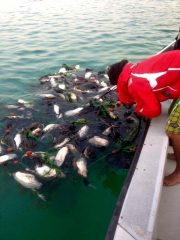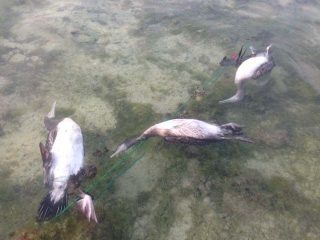All photos by John Reeves
Dozens of birds that inadvertently flew into fishing nets in the waters off of the Pearl-Qatar over the weekend have been killed, according to a rescue team that spent two days trying to save them.
Around 150 birds, believed to be cormorants, were ensnared in 150m of vertical gill nets, which are commonly used for fishing but are controversial because of the danger they pose to other species.
The nets, which look from the water’s surface like a line of rope with little floats, fan down vertically toward the sea floor, capturing things that swim up against them.
Rescuers said the nets were found off of Al Aliyah island, just north of The Pearl-Qatar. The island is a known bird sanctuary and one of just three nesting sites in Qatar for the Socotra cormorant, according to Bird Life International.

The Socotra cormorant is classified as “vulnerable” and is on the Red List of threatened animals produced by The International Union for the Conservation of Nature (IUCN), which is the world’s main authority on the conservation status of species.
Threatened by coastal development around the Gulf, as well as oil spills, the IUCN puts the total breeding population for the bird at only around 110,000 pairs.
It is not known if the trapped birds in this incident were Socotra Cormorants. The great cormorant is also native to Qatar, but not endangered.
Alert call
A paddle boarder first spotted the troubled birds on Jan. 16 and contacted a member of staff at Ronautica, which runs the marina at The Pearl-Qatar.
A team of three people went out to investigate and found a distressing sight of around 150 birds, all believed to be cormorants, tangled in the netting.
John Reeves, head of nautical activities at Ronautica ME, was among those on the rescue mission. He took some video and photographs of the ensnared birds as the team tried to set them free.
In the short clip, some of the birds can be seen frantically flapping their wings as they try to break free from the net.
Speaking to Doha News, Reeves said:
“When we saw what had happened we tried to get hold of the authorities. But it was Friday morning and we couldn’t get through to anyone.
So we went out there to see if we could help. When we got there, we saw about 150 meters of gill net trapping dozens and dozens of birds.”
While some appeared healthy, others were dead or close to death, Reeves added.

He and his colleagues spent the rest of Friday trying to free as many birds as possible. The team returned on Saturday with seven people, who worked all day to release the birds.
In total, they managed to save around 40 to 50 birds, but Reeves estimated that as many as 100 perished in the nets.
“Even of those we did save, they won’t all make it. It takes time for them to recover, and some of them were in a poor condition,” he said.
The team collected the remaining netting and towed it back to the shipyard.
“It was hard work. At least one member of the team had tears in her eyes. It is not nice to see animals caught up in something people left behind,” Reeves continued.
It is not known if the nets were put in that position on purpose or had drifted there.
“Either someone knowingly set it in that area which is a wildlife reserve, or they let it drift there through carelessness. But either way, they have been responsible for the death of about 100 birds,” he added.
Global use
Gill nets have been used as a means of fishing throughout the world for centuries, but while they are effective at trapping fish, they can easily also catch other animals.
In Qatar, it is legal to use some types of gill net, but the nylon monofilament gill nets, which are almost invisible underwater, and three-layers trammel nets are banned, a representative from the Ministry of Environment told Doha News.
The representative said the ministry had not been aware of this incident, and it is not known which type of gill net trapped the birds.
In a statement, the ministry also said that it is illegal to fish near bird sanctuaries such as the one at Al Aliyah Island.
It added that residents can report environmental issues by dialing the Ministry’s 24-hour hotline, 998, which has operators who speak Arabic and English.
The World Wide Fund for Nature warns against the use of gill nets, as they can also capture dolphins and porpoises.
“Gillnets are responsible for the by-catch related deaths of most threatened dolphin and porpoise species,” the group has said.
As a result, the United Nations has banned the use of large-scale (defined as greater than 2.5km) driftnets in international waters, and the EU has placed a ban on driftnets of any length.
Meanwhile in the US state of North Carolina, a petition to ban the use of the nets has been underway. While fishermen can use the nets, they are bound by a number of restrictions, including the requirement to have a permit in some cases.
Thoughts?










